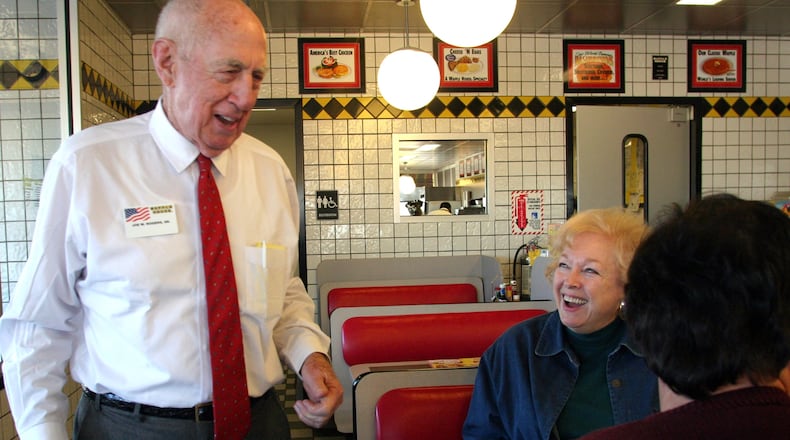The best meal Joe Rogers Sr. ever had was a plate of turnip greens, fatback and cornbread. It was served to him by an elderly black couple in their shack in rural Tennessee on a nasty winter day in 1937.
Rogers crystallized the warmth with which that meal was shared into the core concept for a restaurant empire that now feeds 160 million customers per year.
From the first Waffle House he and business partner Tom Forkner opened 50 years ago in Avondale Estates, to the most recent and 1,470th unit in the chain, that same concept has remained priority No. 1.
"Our job is to make people feel better because they ate with us," said Rogers recently in a rare interview.
Now 85, Rogers can still vividly recall how good it made him feel, when the old man carried two tin cups of coffee out to him and a buddy --- two tired, hungry, dollar-a-week teenaged National Guardsmen patrolling a windswept Mississippi River levee. It seems the governor of Tennessee was afraid some irate farmers on the Missouri side might try to dynamite the levee.
"You boys thirsty?" the man asked. He told them to go inside and have some of the food his wife had just made. While they ate, the man stayed outside, to make sure no one would catch them leaving their post.
"Now, I've had the pleasure of eating in a lot of fancy places in my lifetime, but I can't recall a better meal," Rogers said.
Rogers left West Tennessee to serve as a flight instructor during World War II. He left a secure future in the military to make a go of it in the business world. He eventually became an executive with a restaurant chain, which prepared him to launch Waffle House. It started as a struggling group of three restaurants and grew into the nation's second-largest 24-hour chain, not to mention a landmark of Southern culture.
Credit: Jessica McGowan
Credit: Jessica McGowan
His partner in the venture, Tom Forkner, now 86, worked the real estate and financial aspects of the operation. Rogers was the behind-the-counter specialist who made the human touch into the cornerstone of corporate policy.
Now, Rogers and Forkner have phased themselves out of day-to-day authority, yet they each still spend about half of nearly every weekday in their offices at Waffle House corporate headquarters in Norcross.
And every now and then, they drop in on one of their restaurants.
"I'n not an executive, I'm a waffle cook," Rogers said before a recent field trip to one of the newest Waffle Houses, a unit in Duluth.
Once inside, he quickly flashed his mastery of the "jillion and one" details that every unit manager should know.
While he ate his veggie wrap, he noted the interior rim of the salsa jar needed wiping, so he got up and took care of it. He pulled out a paper napkin to test the air flow around the vent fan over the grill. Then he grumbled about the "Georgia Tech stud ducks" --- a reference to his son Joe Rogers Jr. and fellow Tech alums, who pretty much run the company now --- and how their more modern climate-control systems aren't as customer-friendly as the ones from the early days.
More significantly, Rogers worked the room, chatting animatedly with customers and workers --- the two types of people Rogers most enjoys being around.
Waffle House by the numbers
Credit: JOEY IVANSCO
Credit: JOEY IVANSCO
- 1,470: Number of Waffle House restaurants
- 30,000: Number of Waffle House employees
- 21,000: Miles of bacon strips consumed by Waffle House patrons annually
- 381: Tons of country ham consumed annually at Waffle House
- 2: Percentage of all eggs produced in U.S. annually for food service use that are consumed at Waffle House
- 3.2 million: Pounds of grits consumed each year at Waffle House
Personal connections
Rogers sees the prototypical Waffle House customer as akin to the old cartoon character Dagwood Bumstead. "He's been kicked out of his house, and he's looking for someone to be kind to him," Rogers said. "We're going to feed ol' Bumstead."
The people who scurry through all those eight-hour shifts spent mostly on their feet are also special to Rogers. Overall, about 30,000 people are employed at Waffle Houses.
"Most of our waitresses have hard lives," he said. "A lot of them have a bunch of kids at home, and maybe their husbands don't have good jobs. We can't solve all their problems, but we can listen to them."
Forkner said these sorts of personal connections help make Waffle Houses a haven for widely different types of people. "On any given day, you can have a bank president sitting beside a ditch digger," he said.
All were welcome at Waffle House, even during the years of racial conflict over integration. In 1961, Rogers said, there were sit-in demonstrations at whites-only restaurants. At that point, no black person had asked to be seated at a Waffle House, he said. When demonstrators approached the Waffle House at Peachtree and 10th Street in Atlanta, Rogers defused the protest by inviting everyone inside who wished to eat.
During the riots that hit many cities after the 1968 assassination of the Rev. Martin Luther King, many Atlanta businesses shut down but not the Waffle Houses.
"We haven't ever mistreated anybody, so why should we have to go home?" Rogers recalled thinking. Black leaders later wrote to Rogers to thank him for staying open, he said.
Having that kind of track record on race relations, Rogers said he was upset at first when the company was hit a few years ago with a series of unrelated civil suits alleging incidents of racial discrimination.
"Then I realized it was mostly a result of us getting so big," he said. Nondiscrimination has always been, and continues to be, one of the company's core policies, he said.
Rogers started out in the restaurant industry in 1947, as a short-order cook at a Toddle House restaurant in New Haven, Conn. He was a 27-year-old father of two.
Unlike many other WWll veterans, he decided against using the GI Bill to attend college. "I couldn't figure out how to go to school and take care of those children at the same time," Rogers said.
He learned the art of the grill from cooks who considered themselves hosts, and who sometimes brought their own utensils and skillets to the job, he said. In those days, he said, he made his own soap from leftover grease and lye.
Rogers had become a Toddle House executive in Atlanta by the time he met Forkner in 1949. Six years later, the two formed a partnership to open the first Waffle House.
It was the time when chains of fast-food restaurants were starting to grow explosively, Rogers said. He picked the name Waffle House so people would know it wasn't a place for carry-out food, he said.
Slow growth policy
A year later, Rogers sold his interest to Forkner, primarily so there would be no appearance of conflict with his position at Toddle House. He continued to give long-distance advice to Forkner on operating techniques, however.
For his part, Forkner said, "I never took a nickel out of Waffle House [until Rogers returned]." But when Rogers resigned from Toddle House in 1960, primarily because the new owners rebuffed his proposals for management ownership in the corporation, Forkner persuaded Rogers to come back to Atlanta and take over the restaurant-management end of the Waffle House chain, then consisting of three restaurants.
Rogers was 41 by then, and he and wife Ruth had four children. He went from having his own large office and a secretary to an office space with a milk carton for a chair and a card table for a desk.
The growth came slowly, but that was the way Rogers wanted it. The chain added a new link only when it had enough money to pay for it and enough trained managers to run it the "Waffle House way."
By the time Rogers and Forkner passed most of the operating authority to Joe Rogers Jr. in 1973, there were fewer than 100 Waffle Houses. The growth accelerated dramatically after that, but much about Waffle House has remained essentially the same.
Waffle House restaurants still look pretty much like they did in the early years --- glass boxes with yellow-and-black, block-lettered signs. The prices may be higher, but most of the 16 items on the original menu are still being served.
And just about everything they do still revolves around the maxims of Rogers, the founding "waffle cook." Above and beyond anything else is the priority of "taking care of the poor old cash customer," he said
"We're not in the food business," Joe Rogers Sr. is compulsively fond of saying. "We're in the people business."
About the Author
Keep Reading
The Latest
Featured




